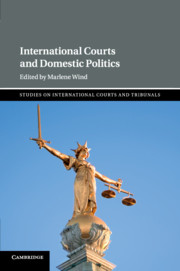Book contents
- International Courts and Domestic Politics
- Studies on International Courts and Tribunals
- International Courts and Domestic Politics
- Copyright page
- Contents
- Figures
- Tables
- Contributors
- Abbreviations
- Preface
- Introduction
- 1 ‘Missing in Action? The Rare Voice of International Courts in Domestic Politics’
- Part I
- Part II
- Index
- References
1 - ‘Missing in Action? The Rare Voice of International Courts in Domestic Politics’
Published online by Cambridge University Press: 23 June 2018
- International Courts and Domestic Politics
- Studies on International Courts and Tribunals
- International Courts and Domestic Politics
- Copyright page
- Contents
- Figures
- Tables
- Contributors
- Abbreviations
- Preface
- Introduction
- 1 ‘Missing in Action? The Rare Voice of International Courts in Domestic Politics’
- Part I
- Part II
- Index
- References
Summary
International courts have proliferated since the mid-twentieth century, but their significance remains contested in academic debates. Constitutionalists contend that the growing interaction between international and national courts exerts a transformative impact on domestic politics, while realists attribute outcomes to the operation of interests and power. Liberals and pluralists expect domestic institutions to mediate the influence of international courts, leading to cross-national variations. I argue that a growing body of empirical research uncovering a wide range of outcomes aligns most consistently with liberal and pluralist expectations. This chapter supports this position by focusing primarily on what should be the ‘easiest’ cases to confirm constitutionalist and realist theories: national courts, European Union (EU) law, and human rights law in Europe and the United States.
- Type
- Chapter
- Information
- International Courts and Domestic Politics , pp. 11 - 42Publisher: Cambridge University PressPrint publication year: 2018
References
- 2
- Cited by

